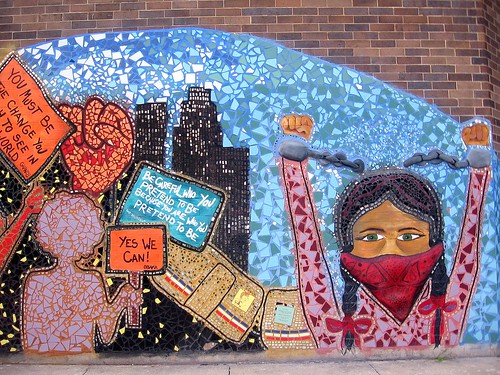Community Art

flickr photo shared by B Darling under a Creative Commons ( BY-NC-SA ) license
Introduction
Europe is currently dealing with one of the largest examples of human migration in modern times, after the Second World War. While there have been many inspiring and highly positive outcomes from the resulting human melting pot, with powerful messages of person-to-person unity, borderless solidarity and an embracing and warm welcoming of the blessing of cultural diversity this brings, all has not been smooth and happy. With increasing Islamophobic, anti-semitic and anti-migrant sentiment spreading across Europe, the far-right gaining popularity in many countries and an apparent snowball effect of vile and violent attacks on individual refugees and whole camps in various countries, there is a growing need to address this alarming growth of unhealthy tension across cultures.
It is clear that a lot of work is still needed to increase the much needed integration. How can we bring people together? Art being present in all cultures is a fantastic way to integrate our visions beyond words. Co-creating art (also known as community art, participatory art, new-genre public art etc) fosters tolerance and community between different cultures and creates a culture of collaboration, this then spreads out into all areas of life. Focusing the art on a social cause can be used as a powerful tool to open the scope of interaction. Engaging the artists in a creative process together acts as a catalyst for social change.
Activity Type
Experiential / Group
Duration
Preparation: a few hours depending on the available options
Duration: 2-3+ hours
Learning Outcomes
To be more accepting of cultural differences
To use the power of community-engaged art to foster togetherness and unity between people among whom there is friction
Instructions
Take a group of youth to a refugee camp in your region [if there are no refugee camps, visit a Roma youth centre or any other organisation that works with people from a different culture]
Make contact with a responsible person where you are going in advance, to get guidelines about what you need to bring, how you should prep the youth before arriving and to see if there are already pre-arranged meeting points.
Arrange the transportation but also feel free to ask the participants to take part in planning to make them feel as part of the project, not as guests, as well as to practice horizontal hierarchy.
Another option is to invite migrants or refugees to the place of the group’s activity or find a common meeting place such as a park or town square.
Integrate people from the camp [or organisation] into the group. Have some ice-breaker games ready in advance, it is important that all the youth feel safe and excited.
Prepare the surface to create the art on, wall, a large canvas or paper etc may be used.
As an introduction tell a ‘desert island story’, where the entire group is stranded on a desert island, abducted and abandoned by aliens. It is now up to the group to design their ideal country/world, together.
Explain that there are no pre-conceived rules they have to follow, there are no borders in place, no countries or states, they may design whatever they want as long as it is together. However, remind all participants that when creating this new world, they must be attentive to the cultural needs of all participants. Everyone should be happy with the final art piece.
Begin!
After the art has been created, organise the space for discussions on the reflection question (see below).
Remember to take pictures! [with consent from everyone in them].
Resources
Reflection
Did something change in your relation to the people around during the creative process?
Have you learnt something new about the culture you came across today?
How did they feel while creating something together – did they feel a sense of team working together?
Was it difficult to be attentive to the cultural needs of the others?
Instructions for Submission
Upload 1 photo and submit a few written impressions of the participants from the discussions. Instructions on how to upload photos and how to submit things in Moodle can be found here: Instructions on Submission&Uploading
Instructions for Assessment
Provide feedback to at least one participant that has done this activity. Instructions on providing feedback can be found here: Instructions on Feedback